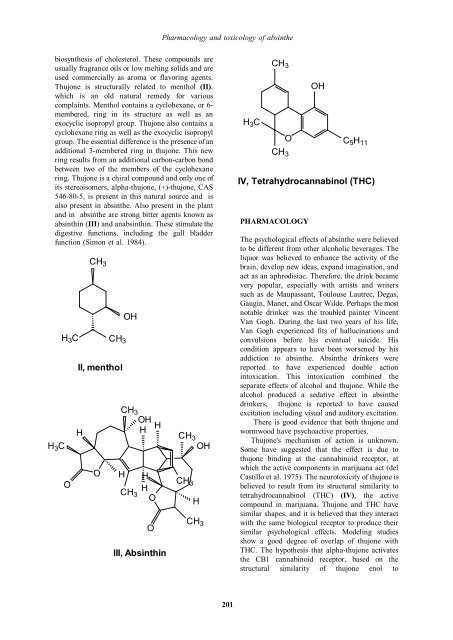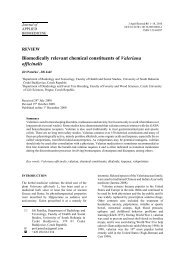Pharmacology and toxicology of absinthe
Pharmacology and toxicology of absinthe
Pharmacology and toxicology of absinthe
Create successful ePaper yourself
Turn your PDF publications into a flip-book with our unique Google optimized e-Paper software.
<strong>Pharmacology</strong> <strong>and</strong> <strong>toxicology</strong> <strong>of</strong> <strong>absinthe</strong><br />
biosynthesis <strong>of</strong> cholesterol. These compounds are<br />
usually fragrance oils or low melting solids <strong>and</strong> are<br />
used commercially as aroma or flavoring agents.<br />
Thujone is structurally related to menthol (II),<br />
which is an old natural remedy for various<br />
complaints. Menthol contains a cyclohexane, or 6-<br />
membered, ring in its structure as well as an<br />
exocyclic isopropyl group. Thujone also contains a<br />
cyclohexane ring as well as the exocyclic isopropyl<br />
group. The essential difference is the presence <strong>of</strong> an<br />
additional 3-membered ring in thujone. This new<br />
ring results from an additional carbon-carbon bond<br />
between two <strong>of</strong> the members <strong>of</strong> the cyclohexane<br />
ring. Thujone is a chiral compound <strong>and</strong> only one <strong>of</strong><br />
its stereoisomers, alpha-thujone, (+)-thujone, CAS<br />
546-80-5, is present in this natural source <strong>and</strong> is<br />
also present in <strong>absinthe</strong>. Also present in the plant<br />
<strong>and</strong> in <strong>absinthe</strong> are strong bitter agents known as<br />
absinthin (III) <strong>and</strong> anabsinthin. These stimulate the<br />
digestive functions, including the gall bladder<br />
function (Simon et al. 1984).<br />
H 3 C<br />
H 3 C<br />
O<br />
CH 3<br />
II, menthol<br />
O<br />
CH 3<br />
OH<br />
CH 3OH<br />
H H H<br />
CH 3<br />
OH<br />
H H<br />
CH<br />
H<br />
3<br />
O<br />
O<br />
III, Absinthin<br />
CH 3<br />
H<br />
CH 3<br />
H 3 C<br />
CH 3<br />
O<br />
C 5 H 11<br />
CH 3<br />
PHARMACOLOGY<br />
OH<br />
IV, Tetrahydrocannabinol (THC)<br />
The psychological effects <strong>of</strong> <strong>absinthe</strong> were believed<br />
to be different from other alcoholic beverages. The<br />
liquor was believed to enhance the activity <strong>of</strong> the<br />
brain, develop new ideas, exp<strong>and</strong> imagination, <strong>and</strong><br />
act as an aphrodisiac. Therefore, the drink became<br />
very popular, especially with artists <strong>and</strong> writers<br />
such as de Maupassant, Toulouse Lautrec, Degas,<br />
Gaugin, Manet, <strong>and</strong> Oscar Wilde. Perhaps the most<br />
notable drinker was the troubled painter Vincent<br />
Van Gogh. During the last two years <strong>of</strong> his life,<br />
Van Gogh experienced fits <strong>of</strong> hallucinations <strong>and</strong><br />
convulsions before his eventual suicide. His<br />
condition appears to have been worsened by his<br />
addiction to <strong>absinthe</strong>. Absinthe drinkers were<br />
reported to have experienced double action<br />
intoxication. This intoxication combined the<br />
separate effects <strong>of</strong> alcohol <strong>and</strong> thujone. While the<br />
alcohol produced a sedative effect in <strong>absinthe</strong><br />
drinkers, thujone is reported to have caused<br />
excitation including visual <strong>and</strong> auditory excitation.<br />
There is good evidence that both thujone <strong>and</strong><br />
wormwood have psychoactive properties.<br />
Thujone's mechanism <strong>of</strong> action is unknown.<br />
Some have suggested that the effect is due to<br />
thujone binding at the cannabinoid receptor, at<br />
which the active components in marijuana act (del<br />
Castillo et al. 1975). The neurotoxicity <strong>of</strong> thujone is<br />
believed to result from its structural similarity to<br />
tetrahydrocannabinol (THC) (IV), the active<br />
compound in marijuana. Thujone <strong>and</strong> THC have<br />
similar shapes, <strong>and</strong> it is believed that they interact<br />
with the same biological receptor to produce their<br />
similar psychological effects. Modeling studies<br />
show a good degree <strong>of</strong> overlap <strong>of</strong> thujone with<br />
THC. The hypothesis that alpha-thujone activates<br />
the CB1 cannabinoid receptor, based on the<br />
structural similarity <strong>of</strong> thujone enol to<br />
201





